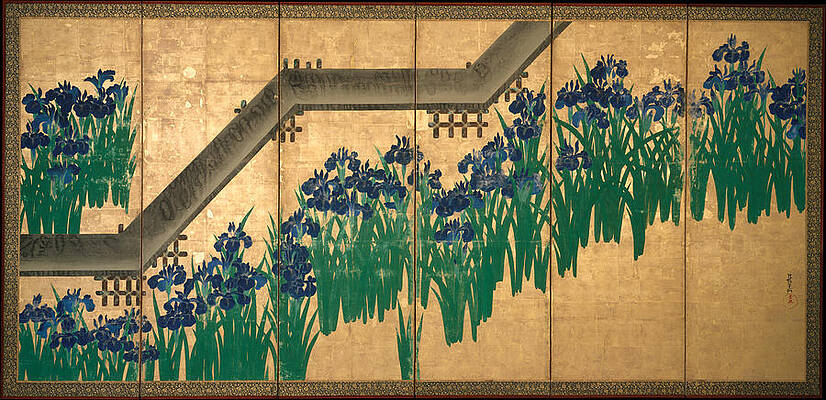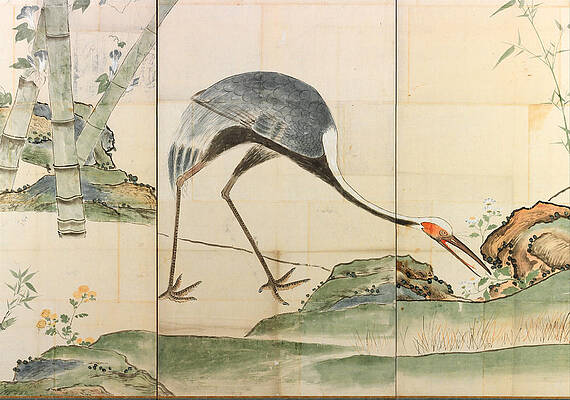Ogata Korin
Cranes Pines and Bamboo
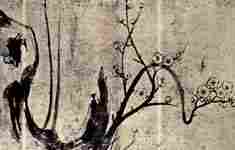

The ball-playing god of happiness Hotei


The deified Sugawara-no-Michizane represented with pine and plum tree branches
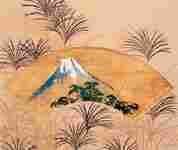
Mount Fuji stands out from the background of the thicket sedge
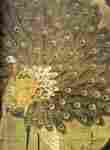
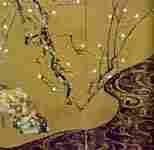
Red and white plum tree; neckline
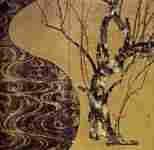
Red and white plum tree; neckline
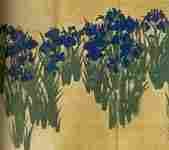

Two-part folding screen: River stream
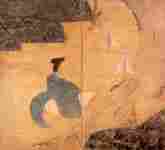
Two-part folding screen: Misogi (cleaning)
Fine Art Prints | Greeting Cards | Phone Cases | Lifestyle | Face Masks | Men's , Women' Apparel | Home Decor | jigsaw puzzles | Notebooks | Tapestries | ...
Irises at Yatsuhashi. Eight Bridges
Ogata Kōrin (尾形光琳?, 1658 – June 2, 1716) was a Japanese painter of the Rinpa school. Kōrin was born in Kyoto, to a wealthy merchant who had a taste for the arts and is said to have given his son some elementary instruction therein. Kōrin also studied under Soken Yamamoto, the Kanō school, Tsunenobu and Gukei Sumiyoshi, and was greatly influenced by his predecessors Hon'ami Kōetsu and Tawaraya Sōtatsu.
Kōrin broke away from all tradition and developed a very original and distinctive style of his own, both in painting and in the decoration of lacquer. The characteristic of this is a bold impressionism, which is expressed in few and simple highly idealized forms, with an absolute disregard for naturalism and the usual conventions. In lacquer, Kōrin's use of white metals and of mother-of-pearl is notable; but here he followed Honami Kōetsu. An artist of the Rinpa school, he is particularly known for his gold-foil folding screens. A screen in the Museum of Fine Arts, Boston depicting Matsushima is a particularly famous work, and his "Irises" in the Nezu Museum is a National Treasure of Japan. Korin died at the age of 59. His chief pupils were Kagei Tatebayashi and Shiko Watanabe, but the present knowledge and appreciation of his work are largely due to the efforts of Sakai Hōitsu, who brought about a revival of Kōrin's style.
In a statistical overview derived from writings by and about Kōrin, OCLC/WorldCat encompasses roughly 200+ works in 300+ publications in 8 languages and 3,000+ library holdings.[2]
光琳畫譜 (1801)
光琳百圖 (1868)
光琳 (1940)
国宝紅白梅図屏風 (1955)
光琳 (1965)
Notes
Nussbaum, Louis-Frédéric. (2005). "Kōrin" in Japan Encyclopedia, p. 561, p. 561, at Google Books.
WorldCat Identities: Ogata, Kōrin 1658-1716
References
Japan portal iconArts portal iconVisual arts portal History portal
Nussbaum, Louis-Frédéric and Käthe Roth. (2005). Japan encyclopedia. Cambridge: Harvard University Press. ISBN 978-0-674-01753-5; OCLC 58053128
Randall, Doanda. (1960). Kōrin. New York: Crown. OCLC 1487440
This article incorporates text from a publication now in the public domain: Edward Fairbrother Strange (1911). "Kōrin, Ogata". In Chisholm, Hugh. Encyclopædia Britannica (11th ed.). Cambridge University Press.
----
Fine Art Prints | Greeting Cards | Phone Cases | Lifestyle | Face Masks | Men's , Women' Apparel | Home Decor | jigsaw puzzles | Notebooks | Tapestries | ...
----
Artist
A - B - C - D - E - F - G - H - I - J - K - L - M -
N - O - P - Q - R - S - T - U - V - W - X - Y - Z
Retrieved from "http://en.wikipedia.org/"
All text is available under the terms of the GNU Free Documentation License


